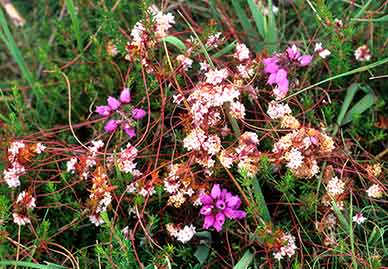Common dodder (Cuscuta epithymum)
When: Best seen from July - September
How many: Fairly widespread, but not often abundant

When compared to most other plants, common dodder really is a strange one, but at least it is relatively easy to identify. Little more than a tangled mass of slender, reddy-coloured threads draped over gorse or heathers; dodder's tiny, pale-pink, densely clustered bell-shaped flowers add to its sense of mystery.
Not only is the appearance of common dodder unusual, though, but so is its lifestyle.
An annual, parasitic plant, in late-spring a slender stem emerges from germinating over-wintered seeds, and entwines itself, always anti-clockwise, around the nearest host plant, providing, of course, that one is within reaching distance.
Common dodder growth at this stage depends entirely on food reserves contained in the seed, for the plant has no green chlorophyll, and therefore cannot photosynthesise. But once the plant is established, the lower part of the stem withers and falls away, leaving the dodder to depend solely on its unfortunate host, from which it takes sugar and other nutrients through suckers that penetrate stem and branches.
Growth is rapid, and it quickly engulfs host and adjacent plants in a tangled cloak of incredibly fine threads, colouring the landscape with a wine-red mantle.
Common dodder is widespread in the New Forest, although not often abundant. Heywood Sumner in 1923 noted that ‘Dodder seems to thrive on the ash left by a Forest fire. New growth heath is often smothered by the crimson threads of this curious parasite.’
That dodder has long been the subject of contempt is reflected in alternative, country names such as hell-weed, devil’s guts, and strangleweed. Indeed, John Pechey in The Compleat Herbal of Physical Plants (1694), pulls no punches at all, contemptuously saying: ’This fawning Parasite, and ungrateful Guest, hugs the Herb it hangs upon, with its long Threads and reddish Twigs; and so closely embraces it, that at length it defrauds the hospitable Herb of its Nourishment, and destroys it by its treacherous Embraces.’
Common dodder is not very nice at all, then!
References:
Collins New Generation Guide - Wild Flowers of Britain and Northern Europe: Alastair Fitter
Reader’s Digest Field Guide to the Wild Flowers of Britain
The Englishman’s Flora: Geoffrey Grigson
A Guide to the New Forest: Heywood Sumner
More links
Other related links
Search this site

Sadly, 58 animals were killed - 35 ponies, 13 cows, 8 donkeys and 2 sheep, whilst a further 32 were injured - 3 pigs, 9 donkeys, 11 cows and 9 ponies.
(Forty-three accidents occurred in daylight, 15 at twilight and 101 in the dark. Twenty-seven accidents were not reported by the driver involved).
Here's just one horrific example - Three donkeys killed in collision with van at notorious New Forest blackspot (Advertiser and Times)

